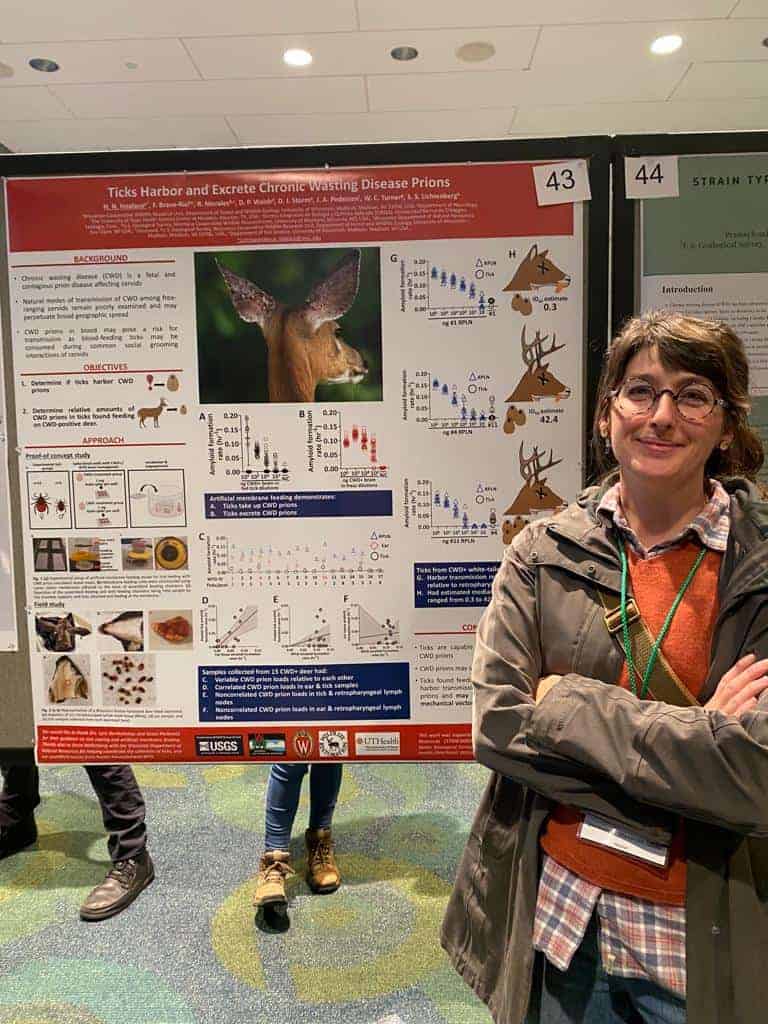Share this article
Best Student Poster explores the role of ticks in CWD transmission
As chronic wasting disease continues to spread through cervid populations in North America, scientists still don’t know exactly how the disease is spreading so rapidly and broadly.
But when Heather Inzalaco’s gears started turning, one mechanism came to mind for white-tailed deer.
“Something that’s overlooked in the literature was their grooming behaviors,” said Inzalaco, a PhD candidate at the University of Wisconsin Madison.
White-tailed deer (Odocoileus virginianus) practice allogrooming. This is when they remove ectoparasites off one another with their mouths. That could mean they are eating tick blood meals that are infected with CWD prions. It could also mean the saliva they leave on their counterparts might further spread the disease.
Inzalaco presented her initial findings at The Wildlife Society’s 2022 Annual Conference in Spokane, which earned her the Best Student Presentation Award. Her poster was titled “Black-Legged Ticks Harbor and Excrete Chronic Wasting Disease Prions from Infected Blood Meals.”
To conduct the research, Inzalaco set up an artificial membrane feeding assay made out of silicon membranes for black-legged ticks (Ixodes scapularis) to feed on in a controlled experimental setting. This way, she was able to control the relative amount of prions in the blood the ticks were feeding on.
“Feeding these little buggers, you’d think would be easy,” she said. “But they’re pretty finicky in a lab setting. There was a lot of trial and error.”
This experiment showed that black-legged ticks could take up prions from the blood meal and excrete them, although Inzalaco doesn’t know yet if the excreted prions are infectious.

Inzalaco stands by her winning poster at the annual TWS conference in Spokane.
Image Credit: Courtesy Heather Inzalaco
After this proof-of-concept experiment, Inzalaco wanted to study ticks on actual deer. She got access to the Wisconsin Department of Natural Resource’s CWD processing facility, where hunter-harvested deer heads are analyzed. Inzalaco set up a table there where she examined thousands of deer heads, removing and cataloging any that were attached. In addition to the use of all of the usual safety precautions like gloves and eye protection, she made sure to wear the lightest colored coveralls to make sure there weren’t any ticks on her.
“Most of them were alive,” she said. “Some were crawling around, and some were attached and still trying to feed. Those were the ones I collected.”
After looking through almost more than 2,000 deer heads, she collected ticks from 175 of them—all of which had some blood meal in them. Lymph node testing showed 15 of the deer heads were CWD-positive. Inzalaco studied the ticks on those 15 deer and found that three had CWD-positive ticks as well. “There were detectable and transmission relevant amounts of CWD prions found in ticks that were feeding on those deer,” she said.
Now that they know ticks can harbor CWD prions at levels potentially relevant for transmission and white-tailed deer exhibit allogrooming behaviors, the next step is looking at whether or not consuming the infected ticks can actually cause disease and if consumption of ticks is occurring frequently among white-tailed deer. “We don’t know how frequently allogrooming events happen,” she said. “It’s an area for future research for how frequently deer are eating ticks and what’s the risk here.”
Overall, Inzalaco said managing for ticks is important. Habitat restoration efforts, for example, can limit the spread of a number of tick-borne diseases, she said. “Things like more native landscaping and reducing edge effects are things that could help indirectly manage tick loads on deer,” she said.
Direct management on deer may be more complicated, though, she said. There are things like scratching posts that deer can rub up against and remove ectoparasites, but species like white-tailed deer are very social. “They’re not just going to stop innate grooming behaviors,” she said.
Inzalaco said she hopes her research helps with CWD management and is grateful that TWS recognized her for it. “I was so moved,” she said. “I couldn’t believe it. To be recognized by The Wildlife Society was a really big deal to me.”







